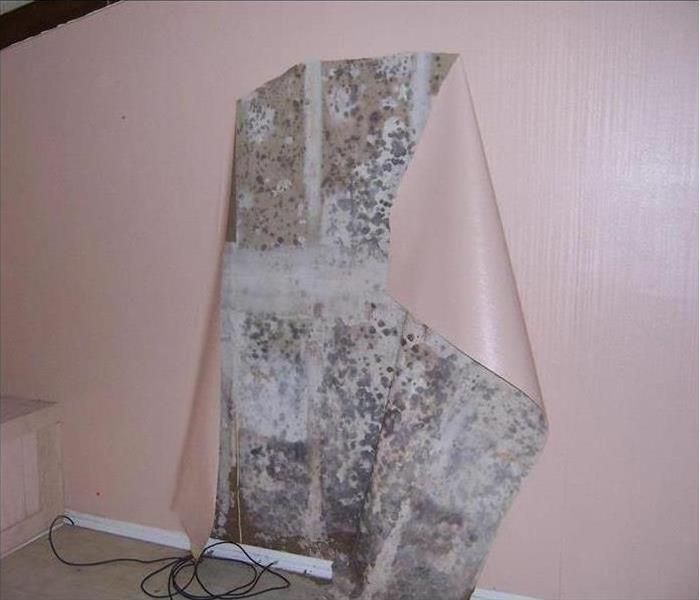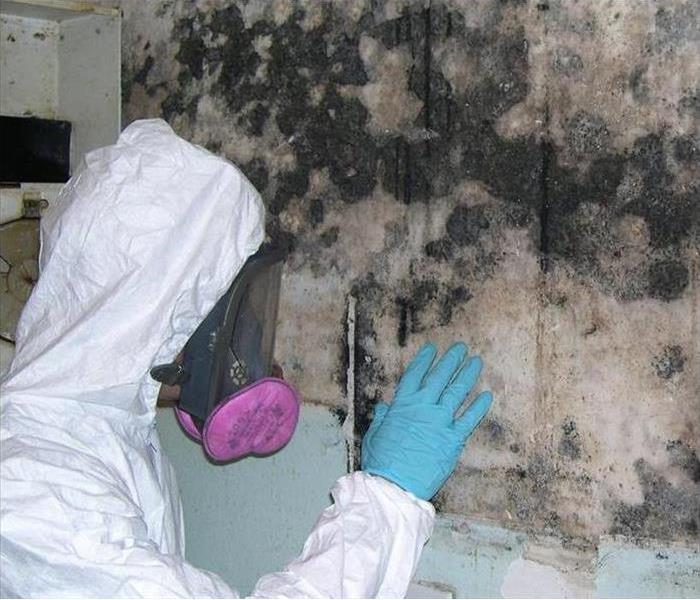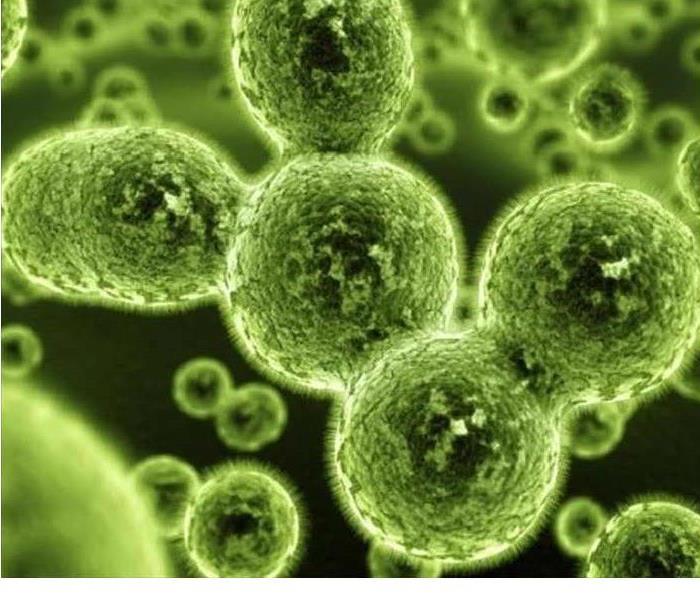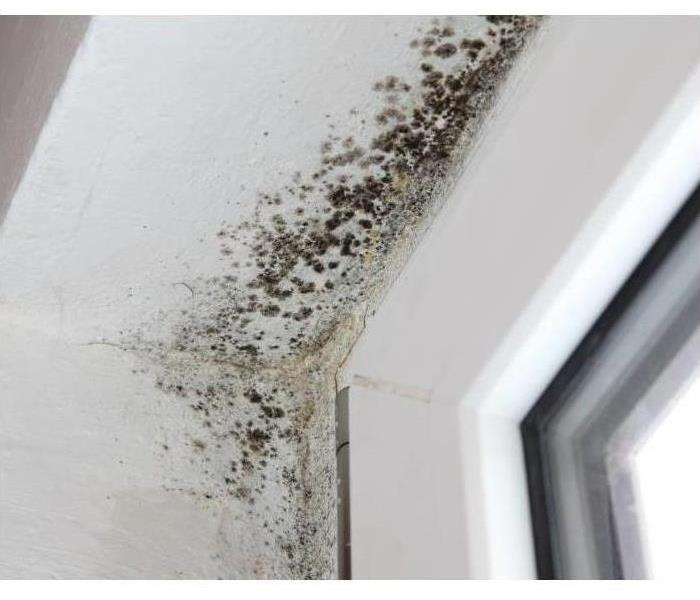Recent Mold Remediation Posts
Understanding Mold: What You Need to Know
2/4/2025 (Permalink)
Microbial growth is a common issue that many homeowners & business owners face, especially in areas with high humidity. At SERVPRO® of Virginia Beach, we understand the challenges microbial growth presents and are here to help you navigate through them. In this blog, we’ll explore what microbial growth is, its causes, and how SERVPRO® can assist in remediation.
What is Microbial Growth?
Microbial growth refers to the development of fungi, bacteria, and other microorganisms in damp environments. It reproduces by releasing spores into the air, which can settle on various surfaces and begin to grow if the conditions are right. Microbial growth can appear in various colors, including black, green, and white, and is often found in moisture-prone areas such as bathrooms, kitchens, and basements.
Causes of Microbial Growth
Microbial growth requires three key ingredients to thrive:
1. Moisture: This is the primary factor for microbial growth. Leaks, floods, or even high humidity can create the perfect environment for microorganisms to flourish.
2. Porous Material: Microbial growth feeds on organic materials like wood, drywall, and even dust.
3. Temperature: Warm environments accelerate microbial growth, making homes in Virginia Beach particularly susceptible during humid summer months.
How SERVPRO® of Virginia Beach Can Help
At SERVPRO® of Virginia Beach, we specialize in microbial growth remediation. Our team is trained to handle microbial infestations safely and effectively. Here’s how we do it:
1. Inspection and Assessment: We conduct a thorough inspection to identify the extent of microbial growth and determine the source of moisture.
2. Containment: To prevent the spread of spores, we contain the affected area using physical barriers and negative air pressure.
3. Microbial Growth Removal: Our professionals use specialized equipment to remove microbial growth and contaminated materials safely.
4. Cleaning and Sanitizing: We clean and sanitize the affected areas to eliminate any remaining spores and help prevent future growth.
5. Restoration: Finally, we restore your home to its pre-damage condition, ensuring it’s safe and healthy for you and your family.
Important Note on Testing
SERVPRO® of Virginia Beach does not typically conduct microbial growth testing. If testing is necessary, we can facilitate an industrial hygienist to assess and provide an independent analysis.
Microbial growth is a serious issue that requires immediate attention. If you suspect microbial growth in your home, don’t hesitate to contact SERVPRO® of Virginia Beach. Our team is ready to assist with expert remediation services, ensuring your home is safe and free from harmful microbial growth. Remember, when it comes to microbial issues, it’s better to be proactive than reactive!
For more information or to schedule an inspection, visit our website or call us today!
Mold Remediation Masters: Why SERVPRO of Virginia Beach Leads the Pack
2/14/2024 (Permalink)
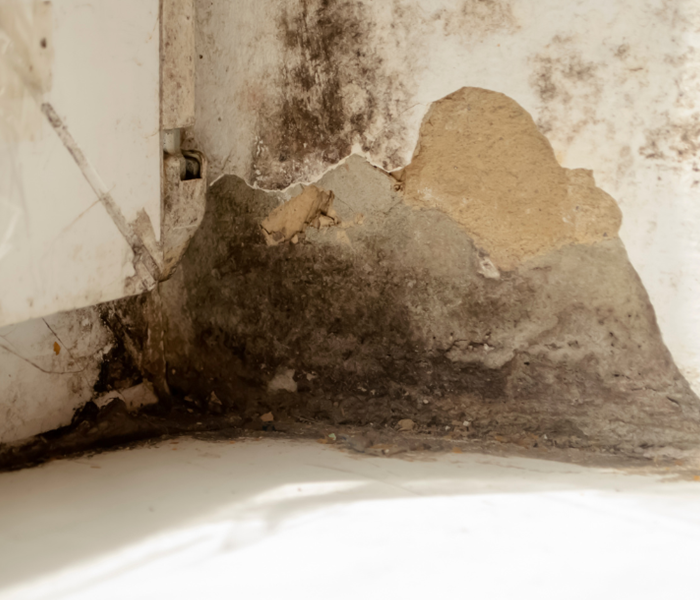 Mold on bottom of wall
Mold on bottom of wall
Mold is a silent menace that can wreak havoc on homes and businesses alike. Its presence not only compromises the structural integrity of buildings but also poses serious health risks to occupants. In the face of mold infestation, swift and effective action is crucial. This is where SERVPRO of Virginia Beach shines as the go-to expert in mold remediation. With a combination of experience, advanced techniques, and a commitment to excellence, we stand out as the premier choice for tackling mold problems head-on.
At SERVPRO of Virginia Beach, mold remediation isn't just a service we offer—it's our specialty. With years of experience under our belt, we've encountered mold in all its forms and know exactly how to combat it. Our team of certified professionals understands the complexities of mold growth, from its preferred environments to its various species. This expertise allows us to develop tailored solutions that address each unique situation effectively.
In the battle against mold, staying ahead of the curve is paramount. That's why SERVPRO of Virginia Beach invests in the latest tools and techniques for mold remediation. From advanced moisture detection devices to state-of-the-art HEPA filtration systems, we leverage technology to identify and mitigate mold at its source. Our methods are not only efficient but also environmentally friendly, minimizing disruption to your property while ensuring thorough mold removal.
Mold remediation is more than just removing visible mold growth—it's about addressing the underlying issues that contribute to its proliferation. At SERVPRO of Virginia Beach, we take a comprehensive approach to mold remediation, focusing not only on eradication but also on prevention. By identifying moisture sources, improving ventilation, and implementing moisture control measures, we help mitigate the risk of future mold outbreaks, safeguarding your property and your health.
When it comes to mold remediation, trust is paramount. That's why SERVPRO of Virginia Beach is proud to be an IICRC-certified firm, adhering to the highest industry standards for mold remediation. Our technicians undergo rigorous training and certification to ensure that they are equipped with the knowledge and skills needed to tackle mold effectively. Additionally, we are fully licensed and insured, providing you with peace of mind knowing that your property is in capable hands.
At SERVPRO of Virginia Beach, customer satisfaction is our top priority. We understand the stress and disruption that mold infestation can cause, which is why we strive to make the remediation process as smooth and hassle-free as possible. From prompt response times to clear communication and transparent pricing, we go above and beyond to exceed our customers' expectations at every turn. When you choose SERVPRO of Virginia Beach, you can trust that you're receiving not only superior mold remediation services but also exceptional customer care.
When mold strikes, don't leave your property's safety and integrity to chance. Trust the experts at SERVPRO of Virginia Beach to deliver prompt, professional, and effective mold remediation services. With our unmatched expertise, cutting-edge techniques, and commitment to customer satisfaction, we'll restore your property to its pre-mold condition, ensuring a safer and healthier environment for you and your loved ones. Don't wait—contact us today and let us put our mold remediation mastery to work for you.
Basic Mold Facts For Virginia Beach
6/20/2023 (Permalink)
What are molds?
Molds are fungi that can be found both indoors and outdoors. No one knows how many species of fungi exist but estimates range from tens of thousands to perhaps three hundred thousand or more. Molds grow best in warm, damp, and humid conditions, and spread and reproduce by making spores. Mold spores can survive harsh environmental conditions, such as dry conditions, that do not support normal mold growth.
What are some of the common indoor molds?
- Cladosporium
- Penicillium
- Alternaria
- Aspergillus
Where are molds found?
Molds are found in virtually every environment and can be detected, both indoors and outdoors, year round. Mold growth is encouraged by warm and humid conditions. Outdoors they can be found in shady, damp areas or places where leaves or other vegetation is decomposing. Indoors they can be found where humidity levels are high, such as basements or showers.
How can people decrease mold exposure?
Sensitive individuals should avoid areas that are likely to have mold, such as compost piles, cut grass, and wooded areas. Inside homes, mold growth can be slowed by controlling humidity levels and ventilating showers and cooking areas. If there is mold growth in your home, you should clean up the mold and fix the water problem. Mold growth can be removed from hard surfaces with commercial products, soap and water, or a bleach solution of no more than 1 cup of household laundry bleach in 1 gallon of water. Follow the manufacturers’ instructions for use (see product label).
If you choose to use bleach to clean up mold:
- Never mix bleach with ammonia or other household cleaners. Mixing bleach with ammonia or other cleaning products will produce dangerous, toxic fumes.
- Open windows and doors to provide fresh air.
- Wear rubber boots, rubber gloves, and goggles during cleanup of affected area.
- If the area to be cleaned is more than 10 square feet, consult the U.S. Environmental Protection Agency (EPA) guide titled Mold Remediation in Schools and Commercial Buildings.
- Always follow the manufacturer’s instructions when using bleach or any other cleaning product.
Specific Recommendations:
- Keep humidity levels as low as you can—no higher than 50%–all day long. An air conditioner or dehumidifier will help you keep the level low. Bear in mind that humidity levels change over the course of a day with changes in the moisture in the air and the air temperature, so you will need to check the humidity levels more than once a day.
- Use an air conditioner or a dehumidifier during humid months.
- Be sure the home has adequate ventilation, including exhaust fans.
- Add mold inhibitors to paints before application.
- Clean bathrooms with mold killing products.
- Do not carpet bathrooms and basements.
- Remove or replace previously soaked carpets and upholstery.
What areas have high mold exposures?
- Antique shops
- Greenhouses
- Saunas
- Farms
- Mills
- Construction areas
- Flower shops
- Summer cottages
I found mold growing in my home, how do I test the mold?
Generally, it is not necessary to identify the species of mold growing in a residence, and CDC does not recommend routine sampling for molds. Current evidence indicates that allergies are the type of diseases most often associated with molds. Since the susceptibility of individuals can vary greatly either because of the amount or type of mold, sampling and culturing are not reliable in determining your health risk. If you are susceptible to mold and mold is seen or smelled, there is a potential health risk; therefore, no matter what type of mold is present, you should arrange for its removal.
A qualified environmental lab took samples of the mold in my home and gave me the results. Can CDC interpret these results?
Standards for judging what is an acceptable, tolerable, or normal quantity of mold have not been established. If you do decide to pay for environmental sampling for molds, before the work starts, you should ask the consultants who will do the work to establish criteria for interpreting the test results. They should tell you in advance what they will do or what recommendations they will make based on the sampling results. The results of samples taken in your unique situation cannot be interpreted without physical inspection of the contaminated area or without considering the building’s characteristics and the factors that led to the present condition.
MOLD in Virginia Beach: What are the 5 MOST TOXIC TYPES?
1/2/2019 (Permalink)
Ascospores are prominent in nature commonly found in the outdoor environment. Some fungi that belong to the Ascomycete family include the sexual forms of Penicillium/Aspergillus, Chaetominum, etc that may be frequently found growing on damp substrates.
Chaetomium are found on a variety of substrates containing cellulose including paper and plant compost. Several species have been reported to play a major role in the decomposition of cellulose-made materials. These fungi are able to dissolve the cellulose fibers in cotton and paper and thus cause the materials to disintegrate. The process is especially rapid under moist conditions. Their Ascospores are brown or gray with one or two germ pores.
Fusarium is a hydrophilic mold that requires very wet conditions and is frequently isolated from plants and grains. They colonize in continuously damp materials such as damp wallboard and water reservoirs for humidifiers and drip pans. While Fusarium Keratitis can be a serious infection, it is a rare disease. Fusarium is commonly found in organic matter such as soil and plants. This infection cannot be transmitted from person to person.
Aspergillus and Penecillium are both types of mold are ubiquitous in the environment. Aspergillus tends to colonize continuously damp materials such as damp wallboard and fabrics. Penicillium is commonly found in house dust, wallpaper, decaying fabrics, moist clipboards, etc.
Stachybotrys is the bad boy of them all
Stachybotrys, commonly called "stachy," is a greenish-black, slimy mold found only on cellulose products (such as wood or paper) that have been wet for several days or more. The mold does not grow on concrete, linoleum or tile. Stachybotrys and some other fungi may produce several toxic chemicals called mycotoxins. Mycotoxins can be present in spores and small mold fragments released into the air. Once the mold fragments, mycotoxins and spores are in the air, individuals may breathe them into their lungs.
Mold Behind Wallpaper
11/23/2018 (Permalink)
Mold behind wallpaper is a big health concern. To get rid of the mold you must remove the wallpaper. First and foremost remove the wallpaper safely by wetting it with a wetting agent and water. But first wear a good cartridge-type respirator.
When removing mold behind wallpaper safely wet it first. Even if the wallpaper removes dry still wet it
A simple dust or particulate mask won't offer adequate protection. Also wear gloves and goggles, remember safety first. In a garden type sprayer add the wetting agent and water for easy application.
Using the sprayer to wet the wallpaper down will reduce the mold spores from becoming airborne. Even if the wallpaper removes dry still wet it first. Move slowly and deliberately so you don't stir up spores as you work.
Once the wallpaper is removed from the walls the next step is to wash the walls down with a water and bleach solution. This should remove the mold from the walls if it is just surface mold. If the walls are soft and spongy the mold may have penetrated deeper into the wall.
One way to tell if the walls are totally saturated with mold you can take a utility knife and cut a small square out of the wall and look at the back side of the square. If there is mold behind the wall then you should replace the walls. If you plan on wallpapering again use a Nonwoven wallpaper so you will never get mold behind wallpaper again. Nonwoven wallpapers can breath unlike vinyl wallpapers.
Virginia Beach Mold Removal and Remediation
11/23/2018 (Permalink)
Any home or business can quickly become infested with mold with the introduction of a water source, like a roof or plumbing leak. Mold can spread throughout a property in as little as 48-72 hours, and can produce allergens and irritants that have the potential to cause other health effects.
If you suspect that your home or business has a mold problem, SERVPRO of Virginia Beach can inspect and assess your property. If mold is found, they have the training, equipment, and expertise to handle the situation.
SERVPRO of Virginia Beach
- Provide 24/7 Emergency Service
- Highly Trained Water Restoration Specialists
- Faster to Any Size Disaster
- A Trusted Leader in the Restoration Industry with over 1,700 Franchises
If You See Signs of Mold, Call SERVPRO of Virginia Beach 757-431-1400.
Understanding Mold
Microscopic mold spores exist almost everywhere, outdoors and indoors, making it impossible to remove all mold from a home or business. Some restoration businesses advertise “mold removal” and even guarantee to remove all mold, which is a fallacy. Consider the following mold facts:
- Mold is present almost everywhere, indoors and outdoors.
- Mold spores are microscopic and float along in the air, and may enter your home through windows, doors, or AC/heating systems or even hitch a ride indoors on your clothing or on a pet.
- Mold spores thrive on moisture. Mold spores can quickly grow into colonies when exposed to water.
- Before mold remediation can begin, any sources of water or moisture must be addressed. Otherwise, the mold may return.
- Mold often produces a strong, musty odor and can lead you to possible mold problem areas.
- Even higher-than-normal indoor humidity can support mold growth. Keep indoor humidity below 45 percent.
Common Mold Misconceptions
With sensational news stories and misleading advertising, you can easily understand why so many people are misinformed about indoor mold. Learn the facts about mold and the mold remediation process.
Basic Mold Facts For Virginia Beach
11/23/2018 (Permalink)
What are molds?
Molds are fungi that can be found both indoors and outdoors. No one knows how many species of fungi exist but estimates range from tens of thousands to perhaps three hundred thousand or more. Molds grow best in warm, damp, and humid conditions, and spread and reproduce by making spores. Mold spores can survive harsh environmental conditions, such as dry conditions, that do not support normal mold growth.
What are some of the common indoor molds?
- Cladosporium
- Penicillium
- Alternaria
- Aspergillus
Where are molds found?
Molds are found in virtually every environment and can be detected, both indoors and outdoors, year round. Mold growth is encouraged by warm and humid conditions. Outdoors they can be found in shady, damp areas or places where leaves or other vegetation is decomposing. Indoors they can be found where humidity levels are high, such as basements or showers.
How can people decrease mold exposure?
Sensitive individuals should avoid areas that are likely to have mold, such as compost piles, cut grass, and wooded areas. Inside homes, mold growth can be slowed by controlling humidity levels and ventilating showers and cooking areas. If there is mold growth in your home, you should clean up the mold and fix the water problem. Mold growth can be removed from hard surfaces with commercial products, soap and water, or a bleach solution of no more than 1 cup of household laundry bleach in 1 gallon of water. Follow the manufacturers’ instructions for use (see product label).
If you choose to use bleach to clean up mold:
- Never mix bleach with ammonia or other household cleaners. Mixing bleach with ammonia or other cleaning products will produce dangerous, toxic fumes.
- Open windows and doors to provide fresh air.
- Wear rubber boots, rubber gloves, and goggles during cleanup of affected area.
- If the area to be cleaned is more than 10 square feet, consult the U.S. Environmental Protection Agency (EPA) guide titled Mold Remediation in Schools and Commercial Buildings.
- Always follow the manufacturer’s instructions when using bleach or any other cleaning product.
Specific Recommendations:
- Keep humidity levels as low as you can—no higher than 50%–all day long. An air conditioner or dehumidifier will help you keep the level low. Bear in mind that humidity levels change over the course of a day with changes in the moisture in the air and the air temperature, so you will need to check the humidity levels more than once a day.
- Use an air conditioner or a dehumidifier during humid months.
- Be sure the home has adequate ventilation, including exhaust fans.
- Add mold inhibitors to paints before application.
- Clean bathrooms with mold killing products.
- Do not carpet bathrooms and basements.
- Remove or replace previously soaked carpets and upholstery.
What areas have high mold exposures?
- Antique shops
- Greenhouses
- Saunas
- Farms
- Mills
- Construction areas
- Flower shops
- Summer cottages
I found mold growing in my home, how do I test the mold?
Generally, it is not necessary to identify the species of mold growing in a residence, and CDC does not recommend routine sampling for molds. Current evidence indicates that allergies are the type of diseases most often associated with molds. Since the susceptibility of individuals can vary greatly either because of the amount or type of mold, sampling and culturing are not reliable in determining your health risk. If you are susceptible to mold and mold is seen or smelled, there is a potential health risk; therefore, no matter what type of mold is present, you should arrange for its removal.
A qualified environmental lab took samples of the mold in my home and gave me the results. Can CDC interpret these results?
Standards for judging what is an acceptable, tolerable, or normal quantity of mold have not been established. If you do decide to pay for environmental sampling for molds, before the work starts, you should ask the consultants who will do the work to establish criteria for interpreting the test results. They should tell you in advance what they will do or what recommendations they will make based on the sampling results. The results of samples taken in your unique situation cannot be interpreted without physical inspection of the contaminated area or without considering the building’s characteristics and the factors that led to the present condition.
8 Bad "Facts" About Mold That Everyone in Virginia Beach Thinks Are True
11/21/2018 (Permalink)
8 Bad “Facts” About Mold That Everyone Thinks Are True
With all the misinformation about mold out there it is easy to over react. Here are four “facts” that are over reactions to mold.
Bad “Fact” 1: All Mold Is Bad
Nope! Have you ever eaten blue cheese or take penicillin? Mold is used in the making this kind of cheese and medicine.
Bad “Fact” 2: All Mold Causes Health Problems
In reality, the effect of mold on people varies greatly. Molds produce allergens, and while some people will be allergic to the allergens produced by mold not everyone will react to mold, and the effects can be varied depending on ones’ sensitivity to mold
People who are highly sensitive to mold may develop allergic reactions and show symptoms such as difficulty breathing, bloody noses, itchy and watery eyes, etc. People with already compromised immune symptoms are also at risk for reacting to mold, and some studies have suggested that serious health effects can arise from repeated exposure to mold, so it is not something to play around with.
Bad “Fact” 3: There Should be No Mold Inside
In reality mold is all around us and is very natural. There are mold spores in the air you are breathing and there is really no way around this unless you decide to live inside a plastic, environmentally controlled bubble. The problem is not that there is mold indoors the problem is with the concentration of mold indoors. Mold should not be growing in your walls or on surfaces as that can be a problem and contribute to allergic reactions.
We will always live with mold, the question is how much mold should we live with? The answer to that is still being worked out. As mold affects people differently you should talk to your doctor if you think you are suffering from exposure to mold and you take steps to reduce your exposure to mold..
Bad “Fact” 4: Bleach Kills Mold
This is kind of a half truth. Bleach may kill certain kinds of mold on non-porous surfaces, however, it is not clear that bleach can kill all kinds of mold nor kill mold on porous surfaces such as wood. Research is continuing to be done on the effectiveness of bleach as a mold cleanup agent. It should be noted that using bleach to “kill” mold poses its own health risks and is not a recommended solution by EPA or OSHA. Bleach is also very corrosive and can cause further damage if not used correctly.
Bad “Fact” 5: Killing Mold is Enough, I Don’t Need to Remove it
Killing mold is not enough. Putting aside the conflicting reports on what kills mold, simply killing mold does not remove the health effects as the allergens are still present even in dead mold. To properly protect against health effects, removal of the affected areas is often necessary. Care must be taken when removing the affected areas so that the allergens and mold is not spread throughout the house. That is why professional mold remediation services are often necessary to properly fix a mold problem.
Bad “Fact” 6: Mold is Natural, You Shouldn’t Worry About it
While mold may be natural, consistent exposure to mold can have negative affects on ones health. If mold is growing in your home or place of business it needs to be addressed as it will deteriorate your building and can cause health problems.
Bad “Fact” 7: If You Only See a Little Mold it is Probably Nothing to Worry About
If mold is to the point where it is visibly growing on surfaces in your home you have a problem. Mold is like an iceberg, you generally only see the tip of it while the majority is below the surface. If you see a little bit of mold you most likely have more growing under the surface out of site.
Bad “Fact” 8: Cleaning up Mold isn’t Hard. You Should Do it Yourself
This is another half truth. While you may be able to clean up certain kinds of mold in small quantities most people are not equipped to do proper mold remediation. Simply wiping down the evidence is not good enough. To properly “cleanup” a mold problem you must identify the cause, isolate the area to keep the mold from spreading, and clean and or remove the affected surfaces. Unless you know how to setup a containment unit, have a couple of commercial sized HEPA air filtration units, protective gear, HEPA vacuums, specialized cleaning agents, and can do a wet extraction to keep mold spores from spreading. Call SERVPRO of Virginia Beach if you think you may have any mold. 757-431-1400.
Mold Prevention Tips
5/21/2018 (Permalink)
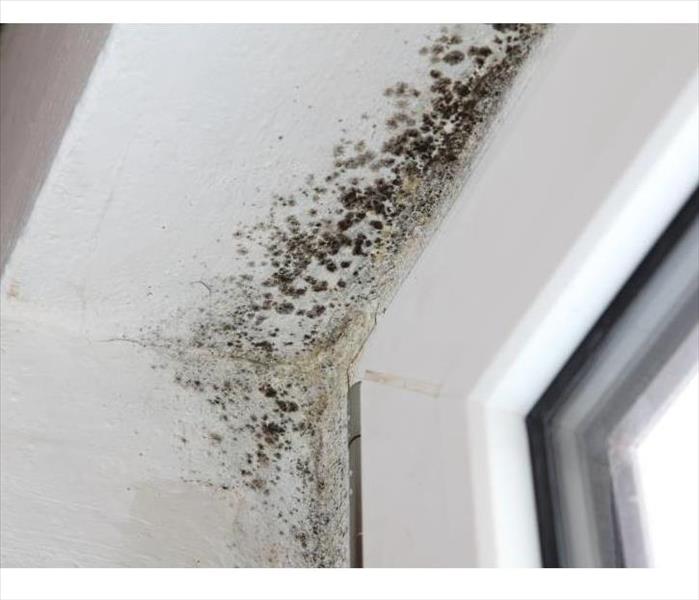
Mold. The very sound of the word is enough to make a person cringe.
Yes, mold can be good-- it's essential in making brie and penicillin, for example, but it can also be very, very bad, especially when it grows undetected in your home.Some Facts About Mold
Mold spores spread easily and cannot be completely eradicated. Mold can grow anywhere: on carpet, clothing, food, paper and even in places you can't see, such as the back of drywall, areas inside walls around leaking or condensing pipes, or above ceiling tiles. Not only is a mold problem difficult and costly to fix, but mold can also produce allergens and irritants (and rarely, toxins) that may compromise your health. So what can you do if you're concerned about mold growing on a property? The best approach is preventing mold before it becomes a problem. And the key to mold prevention is simple: moisture control. Mold Prevention Tips
Click below for nine ways to curb moisture indoors, and the mold that thrives on it.
9 Ways to Curb Indoor Moisture and Prevent Mold:
1. Identify problem areas and correct them. You can't mold-proof a property, but you can make it mold-resistant. Do an audit of the property: where are the problem areas? Does the basement flood? Do you notice frequent condensation on an upstairs window? Is there a water stain on the ceiling from a persistent leak? Preventing mold from growing or spreading might be as simple as ripping up carpet in a damp basement, installing mold-resistant products, or repairing damaged gutters. Or it may be a matter of major excavation and waterproofing. Whatever the case, address the problem now. It might cost some money up front, but it will surely be more costly down the road if mold continues to grow unchecked.
2. Dry wet areas immediately. Mold can't grow without moisture, so tackle wet areas right away. Seepage into the basement after a heavy rainfall, accumulation from a leaky pipe, even a spill on the carpet should be dried within 24 to 48 hours. If you've experienced a flood, remove water-damaged carpets, bedding, and furniture if they can't be completely dried. Even everyday occurrences need attention: don't leave wet items lying around the house, and make sure to dry the floor and walls after a shower. Don't leave wet clothes in the washing machine, where mold can spread quickly. Hang them to dry — preferably outside or in areas with good air circulation.
3. Prevent moisture with proper ventilation. It may be that your routine domestic activities are encouraging the growth of mold in the property. Make sure an activity as simple as cooking dinner, taking a shower, or doing a load of laundry doesn't invite mold by providing proper ventilation in your bathroom, kitchen, laundry room, and any other high-moisture area. Vent appliances that produce moisture — clothes dryers, stoves — to the outside (not the attic). Use AC units and dehumidifiers (especially in humid climates), but make sure they don’t produce moisture themselves by checking them periodically and cleaning them as directed by the manufacturer. Your energy-efficient property may be holding moisture inside, so open a window when cooking or washing dishes or showering, or run an exhaust fan.
4. Equip the property with mold-resistant products. Building a new home or renovating an old one? Use mold-resistant products like mold-resistant drywall or mold-resistant Sheetrock, and mold inhibitors for paints. Traditional drywall is composed of a gypsum plaster core pressed between plies of paper. Mold-resistant drywall is paperless — the gypsum core is covered in fiberglass, making the surface highly water-resistant. Moisture-resistant drywall is especially valuable in areas prone to wetness, such as bathrooms, laundry rooms, basements, and kitchens. Not only is traditional drywall more susceptible to mold than the paperless kind, but it is also difficult to rid of mold, and removal and replacement can be expensive. Mold-resistant gypsum board is also available; the core of the drywall is developed in such a way to prevent moisture absorption, and thus prevent mold growth.
5. Monitor humidity indoors. The EPA recommends keeping indoor humidity between 30 and 60 percent. You can measure humidity with a moisture. You'll also be able to detect high humidity by simply paying attention to potential problem areas of the property. Telltale signs of excessive humidity include condensation on windows, pipes, and walls. If you notice condensation, dry the surface immediately and address the source of moisture. (For example, turn off a humidifier if water appears on the inside of nearby windows.)
6. Direct water away from the property. If the ground around the property isn't sufficiently sloped away from the foundation, water may collect there and seep into your crawlspace or basement.
7. Clean or repair roof gutters. A mold problem might be a simple matter of a roof that is leaking because of full or damaged gutters. Have your roof gutters cleaned regularly and inspected for damage. Repair them as necessary, and keep an eye out for water stains after storms that may indicate a leak.
8. Improve air flow in your home. According to the EPA, as temperatures drop, the air is able to hold less moisture. Without good air flow in a property, that excess moisture may appear on your walls, windows and floors. To increase circulation, open doors between rooms, move furniture away from walls, and open doors to closets that may be colder than the rooms they’re in. Let fresh air in to reduce moisture and keep mold at bay.
9. Keep mold off household plants. They're beautiful and help keep your indoor air clean — and mold loves them. The moist soil in indoor plants is a perfect breeding ground for mold, which may then spread to other areas of your house. Instead of getting rid of your plants, try adding a bit of Taheebo tea to the water you give to your houseplants. The oil of this tree, which withstands fungi even in rain forests, helps hinder mold growth in plant soil and can be found at natural food stores.
Finally, educate yourself on your region's climate — be it the cold and wet Northeast, the hot and wet South, the hot and dry Southwest, or the cold and dry West — and how it responds to moisture. There is no one-size-fits-all solution when it comes to mold prevention. Knowing what works for your climate and your home is an important first step.
Mold Behind Wall Paper
12/6/2017 (Permalink)
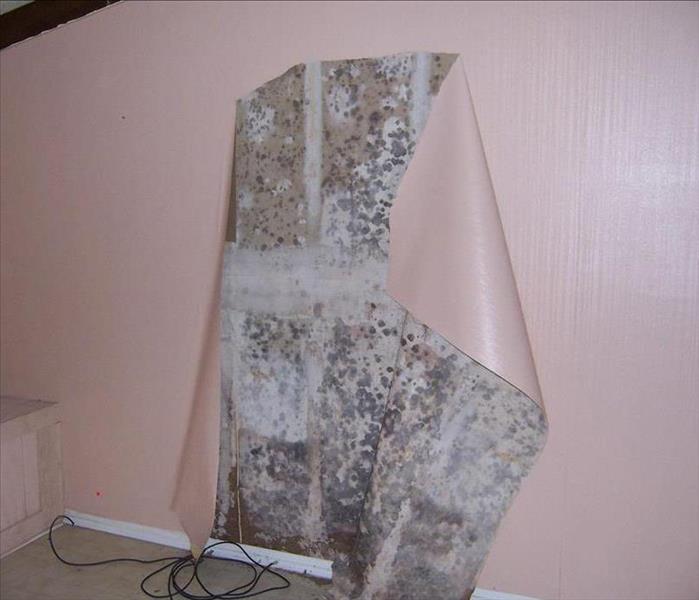 Mold
Mold
Mold behind wallpaper is a big health concern. To get rid of the mold you must remove the wallpaper. First and foremost remove the wallpaper safely by wetting it with a wetting agent and water. But first wear a good cartridge-type respirator.
When removing mold behind wallpaper safely wet it first. Even if the wallpaper removes dry still wet itA simple dust or particulate mask won't offer adequate protection. Also wear gloves and goggles, remember safety first. In a garden type sprayer add the wetting agent and water for easy application.
Using the sprayer to wet the wallpaper down will reduce the mold spores from becoming airborne. Even if the wallpaper removes dry still wet it first. Move slowly and deliberately so you don't stir up spores as you work.
Once the wallpaper is removed from the walls the next step is to wash the walls down with a water and bleach solution. This should remove the mold from the walls if it is just surface mold. If the walls are soft and spongy the mold may have penetrated deeper into the wall.
One way to tell if the walls are totally saturated with mold you can take a utility knife and cut a small square out of the wall and look at the back side of the square. If there is mold behind the wall then you should replace the walls. If you plan on wallpapering again use a Nonwoven wallpaper so you will never get mold behind wallpaper again. Nonwoven wallpapers can breath unlike vinyl wallpapers.
Mold Removal and Mold Remediation
12/4/2017 (Permalink)
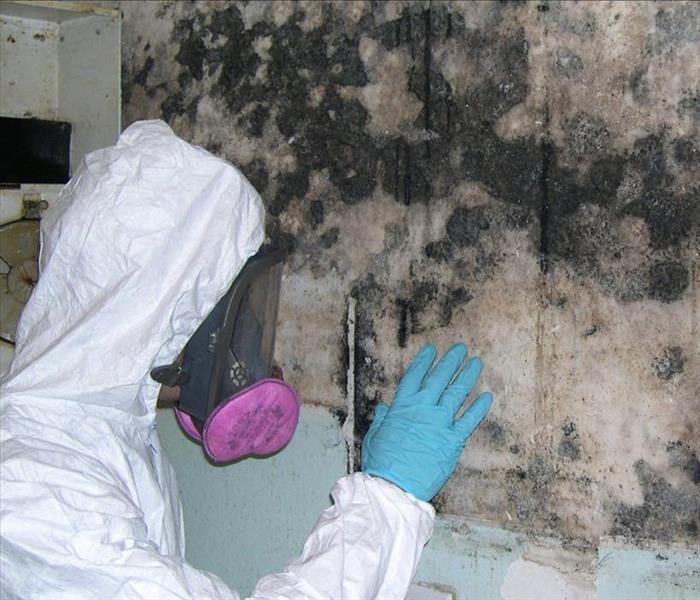 Mold
Mold
Any home or business can quickly become infested with mold with the introduction of a water source, like a roof or plumbing leak. Mold can spread throughout a property in as little as 48-72 hours, and can produce allergens and irritants that have the potential to cause other health effects.
If you suspect that your home or business has a mold problem, SERVPRO Franchise Professionals can inspect and assess your property. If mold is found, they have the training, equipment, and expertise to handle the situation.
SERVPRO Franchise Professionals
- Provide 24/7 Emergency Service
- Highly Trained Water Restoration Specialists
- Faster to Any Size Disaster
- A Trusted Leader in the Restoration Industry with over 1,700 Franchises
If You See Signs of Mold, Call SERVPRO 757-431-1400.
Understanding Mold
Microscopic mold spores exist almost everywhere, outdoors and indoors, making it impossible to remove all mold from a home or business. Some restoration businesses advertise “mold removal” and even guarantee to remove all mold, which is a fallacy. Consider the following mold facts:
- Mold is present almost everywhere, indoors and outdoors.
- Mold spores are microscopic and float along in the air, and may enter your home through windows, doors, or AC/heating systems or even hitch a ride indoors on your clothing or on a pet.
- Mold spores thrive on moisture. Mold spores can quickly grow into colonies when exposed to water.
- Before mold remediation can begin, any sources of water or moisture must be addressed. Otherwise, the mold may return.
- Mold often produces a strong, musty odor and can lead you to possible mold problem areas.
- Even higher-than-normal indoor humidity can support mold growth. Keep indoor humidity below 45 percent.
Common Mold Misconceptions
With sensational news stories and misleading advertising, you can easily understand why so many people are misinformed about indoor mold. Learn the facts about mold and the mold remediation process.
8 Bad "Facts" ABout Mold Everyone Thinks Are True
11/16/2017 (Permalink)
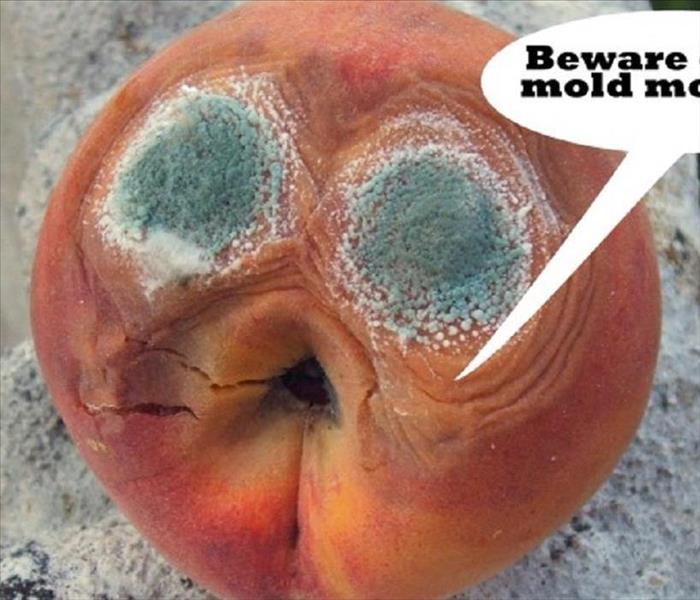 Mold Monster
Mold Monster
8 Bad “Facts” About Mold That Everyone Thinks Are True
With all the misinformation about mold out there it is easy to over react. Here are four “facts” that are over reactions to mold.
Bad “Fact” 1: All Mold Is Bad
Nope! Have you ever eaten blue cheese or take penicillin? Mold is used in the making this kind of cheese and medicine.
Bad “Fact” 2: All Mold Causes Health Problems
In reality, the effect of mold on people varies greatly. Molds produce allergens, and while some people will be allergic to the allergens produced by mold not everyone will react to mold, and the effects can be varied depending on ones’ sensitivity to mold
People who are highly sensitive to mold may develop allergic reactions and show symptoms such as difficulty breathing, bloody noses, itchy and watery eyes, etc. People with already compromised immune symptoms are also at risk for reacting to mold, and some studies have suggested that serious health effects can arise from repeated exposure to mold, so it is not something to play around with.
Bad “Fact” 3: There Should be No Mold Inside
In reality mold is all around us and is very natural. There are mold spores in the air you are breathing and there is really no way around this unless you decide to live inside a plastic, environmentally controlled bubble. The problem is not that there is mold indoors the problem is with the concentration of mold indoors. Mold should not be growing in your walls or on surfaces as that can be a problem and contribute to allergic reactions.
We will always live with mold, the question is how much mold should we live with? The answer to that is still being worked out. As mold affects people differently you should talk to your doctor if you think you are suffering from exposure to mold and you take steps to reduce your exposure to mold..
Bad “Fact” 4: Bleach Kills Mold
This is kind of a half truth. Bleach may kill certain kinds of mold on non-porous surfaces, however, it is not clear that bleach can kill all kinds of mold nor kill mold on porous surfaces such as wood. Research is continuing to be done on the effectiveness of bleach as a mold cleanup agent. It should be noted that using bleach to “kill” mold poses its own health risks and is not a recommended solution by EPA or OSHA. Bleach is also very corrosive and can cause further damage if not used correctly.
Bad “Fact” 5: Killing Mold is Enough, I Don’t Need to Remove it
Killing mold is not enough. Putting aside the conflicting reports on what kills mold, simply killing mold does not remove the health effects as the allergens are still present even in dead mold. To properly protect against health effects, removal of the affected areas is often necessary. Care must be taken when removing the affected areas so that the allergens and mold is not spread throughout the house. That is why professional mold remediation services are often necessary to properly fix a mold problem.
Bad “Fact” 6: Mold is Natural, You Shouldn’t Worry About it
While mold may be natural, consistent exposure to mold can have negative affects on ones health. If mold is growing in your home or place of business it needs to be addressed as it will deteriorate your building and can cause health problems.
Bad “Fact” 7: If You Only See a Little Mold it is Probably Nothing to Worry About
If mold is to the point where it is visibly growing on surfaces in your home you have a problem. Mold is like an iceberg, you generally only see the tip of it while the majority is below the surface. If you see a little bit of mold you most likely have more growing under the surface out of site.
Bad “Fact” 8: Cleaning up Mold isn’t Hard. You Should Do it Yourself
This is another half truth. While you may be able to clean up certain kinds of mold in small quantities most people are not equipped to do proper mold remediation. Simply wiping down the evidence is not good enough. To properly “cleanup” a mold problem you must identify the cause, isolate the area to keep the mold from spreading, and clean and or remove the affected surfaces. Unless you know how to setup a containment unit, have a couple of commercial sized HEPA air filtration units, protective gear, HEPA vacuums, specialized cleaning agents, and can do a wet extraction to keep mold spores from spreading. Call SERVPRO of Virginia Beach if you think you may have any mold. 757-431-1400.
Basic Mold Facts
11/16/2017 (Permalink)
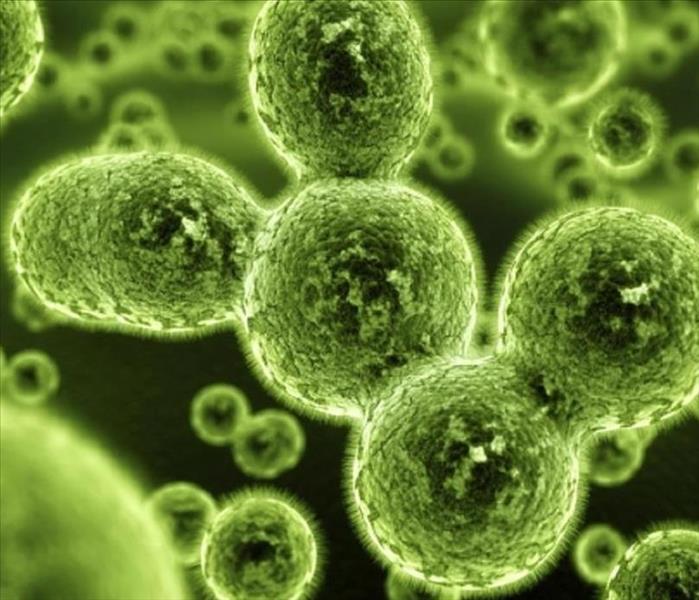 Green Mold
Green Mold
What are molds?
Molds are fungi that can be found both indoors and outdoors. No one knows how many species of fungi exist but estimates range from tens of thousands to perhaps three hundred thousand or more. Molds grow best in warm, damp, and humid conditions, and spread and reproduce by making spores. Mold spores can survive harsh environmental conditions, such as dry conditions, that do not support normal mold growth.
What are some of the common indoor molds?
- Cladosporium
- Penicillium
- Alternaria
- Aspergillus
Where are molds found?
Molds are found in virtually every environment and can be detected, both indoors and outdoors, year round. Mold growth is encouraged by warm and humid conditions. Outdoors they can be found in shady, damp areas or places where leaves or other vegetation is decomposing. Indoors they can be found where humidity levels are high, such as basements or showers.
How can people decrease mold exposure?
Sensitive individuals should avoid areas that are likely to have mold, such as compost piles, cut grass, and wooded areas. Inside homes, mold growth can be slowed by controlling humidity levels and ventilating showers and cooking areas. If there is mold growth in your home, you should clean up the mold and fix the water problem. Mold growth can be removed from hard surfaces with commercial products, soap and water, or a bleach solution of no more than 1 cup of household laundry bleach in 1 gallon of water. Follow the manufacturers’ instructions for use (see product label).
If you choose to use bleach to clean up mold:
- Never mix bleach with ammonia or other household cleaners. Mixing bleach with ammonia or other cleaning products will produce dangerous, toxic fumes.
- Open windows and doors to provide fresh air.
- Wear rubber boots, rubber gloves, and goggles during cleanup of affected area.
- If the area to be cleaned is more than 10 square feet, consult the U.S. Environmental Protection Agency (EPA) guide titled Mold Remediation in Schools and Commercial Buildings.
- Always follow the manufacturer’s instructions when using bleach or any other cleaning product.
Specific Recommendations:
- Keep humidity levels as low as you can—no higher than 50%–all day long. An air conditioner or dehumidifier will help you keep the level low. Bear in mind that humidity levels change over the course of a day with changes in the moisture in the air and the air temperature, so you will need to check the humidity levels more than once a day.
- Use an air conditioner or a dehumidifier during humid months.
- Be sure the home has adequate ventilation, including exhaust fans.
- Add mold inhibitors to paints before application.
- Clean bathrooms with mold killing products.
- Do not carpet bathrooms and basements.
- Remove or replace previously soaked carpets and upholstery.
What areas have high mold exposures?
- Antique shops
- Greenhouses
- Saunas
- Farms
- Mills
- Construction areas
- Flower shops
- Summer cottages
I found mold growing in my home, how do I test the mold?
Generally, it is not necessary to identify the species of mold growing in a residence, and CDC does not recommend routine sampling for molds. Current evidence indicates that allergies are the type of diseases most often associated with molds. Since the susceptibility of individuals can vary greatly either because of the amount or type of mold, sampling and culturing are not reliable in determining your health risk. If you are susceptible to mold and mold is seen or smelled, there is a potential health risk; therefore, no matter what type of mold is present, you should arrange for its removal.
A qualified environmental lab took samples of the mold in my home and gave me the results. Can CDC interpret these results?
Standards for judging what is an acceptable, tolerable, or normal quantity of mold have not been established. If you do decide to pay for environmental sampling for molds, before the work starts, you should ask the consultants who will do the work to establish criteria for interpreting the test results. They should tell you in advance what they will do or what recommendations they will make based on the sampling results. The results of samples taken in your unique situation cannot be interpreted without physical inspection of the contaminated area or without considering the building’s characteristics and the factors that led to the present condition.
Mold Found in Local Virginia Beach, VA Home
11/16/2017 (Permalink)
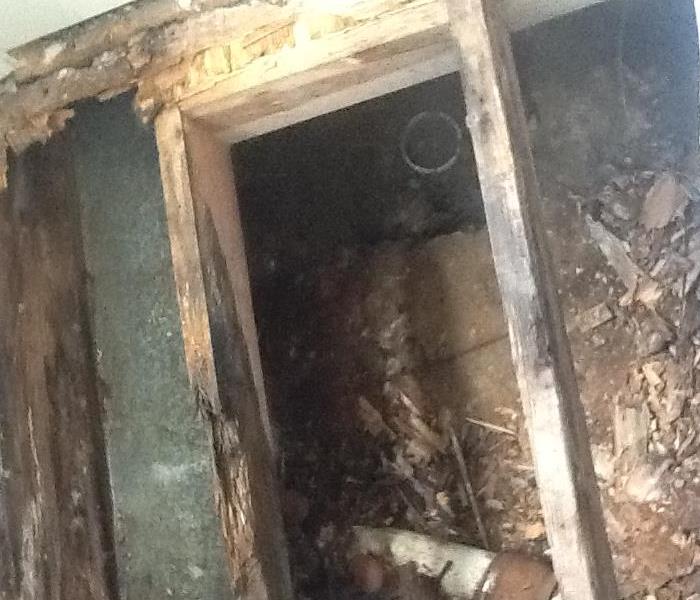 Mold beneath wall
Mold beneath wall
Mold on wall11/10/2017
This mold was found after this local family called us for a pipe burst that happened behind their wall. Our technicians saw this after doing demolition and wanted to get this tested before resuming to make sure this was mitigated properly. After confirming with the industrial hygienists that this was indeed mold we performed the proper mitigation. Such as wearing the correct PPE, setting air scrubbers, sanitizing, and also doing tear out as needed to ensure that it was gone.
Please be sure to call SERVPRO of Virginia Beach for any mitigation needs you may have. 757-431-1400
10 Facts About Black Mold
11/16/2017 (Permalink)
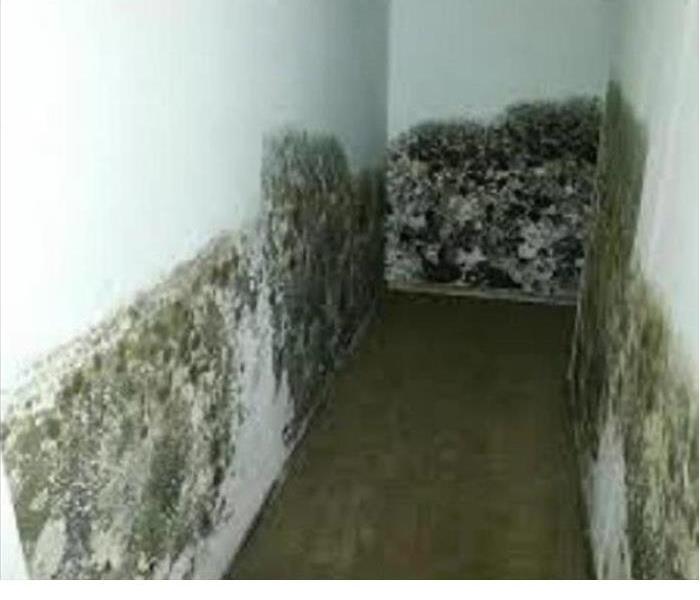 Mold
Mold
Here Are 10 Facts About Stachybotrys Mold That You Need to Know
1. The “Toxic Black Mold” People Are Most Concerned About Is Called Stachybotrys Chartarum or Stachybotrys Atra.
For the purposes of this article I have interchanged the names Stachybotrys, Black Mold and Stachy to mean the same thing.
In fact, this particular mold gained wide scale recognition as one of the most harmful fungi, especially in the United States. Back in 1993-1994, there was a serious outbreak of pulmonary hemorrhage affecting infants in Cleveland Ohio.
Research revealed that Stachybotrys Chartarum growing inside the home of the sick infants.
Since that time there have been a number of other cases involving “Toxic Black Mold” across the nation, resulting in lawsuits and problems for building owners on how to address this issue.
However, there is much debate regarding the specifics on this topic with regard to medical claims… yet the common consensus is that people get sick when they ingest or breathe the harmful mycotoxins from this fungus.
It should also be stressed that several other non-related mold types, including Aspergillus can be dangerous as well. Some of these other molds are black, as well as green, blue, pink, brown, white and yellow.
Anytime you see a moisture issue and resulting mold in your home or building, the situation must be addressed in short order. Call in a professional for best results.
2. According To The Centers for Disease Control and Prevention, Black Mold, And All Other Mold Is Not Toxic…
The term “Toxic Mold” is apparently incorrect. Instead, it is the mycotoxins released from this fungus that are considered toxic. I have included a link at the bottom of this article for more clarification on this.
3. Black Mold May Or May Not Produce Toxins.
According to another article written in Mold-Help.org blog, there are a variety of conditions that will determine whether a mold will produce toxins. Although this mold has the ability to produce health compromising toxins, they do not always release the poisons.
It depends on a number of factors, such as the surface it is grows on, the temperature, the food source and humidity.
4. Stachybotrys Is A Wet, Sticky Mold.
Stachy spores are clumped together in a sticky coating so they do not usually travel well in air currents like many other mold types. However, if they dry out or become disturbed, they can be disbursed.
Dry mold is not really dead; it lies dormant and can still be dangerous. In the dry state it can take on the appearance of soot.
Due to its sticky make up, Stachy is best collected and tested by taking physical swab or tape surface samples. They can then be sent to a microbial lab for analysis.
Inspectors may suspect that a home has Stachybotrys, (based on visible observation) yet still choose to conduct air samples to determine if any other kinds of mold are present.
Knowing that these spores do not travel well in the air, you should be especially concerned if the only one tiny Stachybotrys clump is revealed in a lab report. This is a clear indication that thousands more are likely to be present.
5. Excessive Prolonged Moisture Leads To Stachybotrys growth.
This fungus needs to be exposed to moisture for long periods of time (1-2 weeks) before it begins to colonize.
Other mold types commonly found in a home, such as Aspergillus, Penecillium and Cladosporium, can grow within 24-48 hours.
Indoors, it grows best on organic cellular materials like insulation paper backing, drywall, ceiling tiles, cardboard, wallpaper or any other paper based materials.
A quick case study: During one of my inspections, a large concentration of Stachybotrys Chartarum was found behind a mattress leaning along a bedroom wall. According to the strata president, this was caused by high humidity over a three-month stretch.
Normally one would expect to see this fungus growing because of a long-standing flood or leak rather than high humidity.
To save money, the homeowners were air-drying all of their laundry in one bedroom, while keeping the windows and door closed. It was like a humid rain forest.
The takeaway from this… high humidity over time can cause this fungus to grow. Keep the windows open (about an inch or two) for cross ventilation and always use the dryer rather than hanging moist clothing in a closed room.
6. Poisonous Toxins Released By Stachy, And Other Molds Are Called Mycotoxins.
These poisons (mycotoxins) are what make people ill when they are ingested or inhaled. Another reason this mold has been called Toxic Black Mold is due to the fact that it produces more mycotoxins than most other types of indoor mold.
7. Toxic Black Mold Is Not Always Visible.
This mold is not easily seen for a number of reasons. It needs to be sitting in moisture for at least 8 days to begin growing. Visible leaks are usually dealt with right away, so it wouldn’t have the time to colonize.
A small leak that develops over time can start the process when the leak is not visible. Problems begin without us knowing, as many leaks are concealed behind walls, and under carpets, floorboards above the ceiling in and areas that have been saturated for long periods of time.
At this point is it too late… People begin to experience health effects, or eventually see the signs once it has established a presence. By this time, the subsequent damage can be vast and expensive.
8. This Black Mold Has A Very Distinctive Odour.
Some would describe it as a potent, damp, stale, musty or rotting earthy wood smell. If this strong type of odour is present, yet different from other rooms in the home, then the area should be investigated for mold infestation. Consider this a priority.
9. Over Time, Stachy Will Usually Dominate Other Molds.
Through testing and analysis we know that this mold grows best when exposed to moisture for at least a week, or more. When its food source is low in nitrogen and high in cellulose, (organic materials) Stachy is happy… us and other molds, not so much.
Although different mold colonies will likely grow beforehand, once the Stachy takes form, it will dominate the environment completely.
10. Dry Mold Will Grow Again When Exposed To Moisture.
It’s true… Stachybotrys and several other mold types can sit dormant for thousands of years until it gets wet, allowing new growth to take form.
For this reason, I strongly recommend calling in a professional remediation contractor to discard all contaminated items, and or building materials.
Call SERVPRO of Virginia Beach for any mold remediation needs you may have. 757-431-1400
Facts About Mold
11/8/2017 (Permalink)
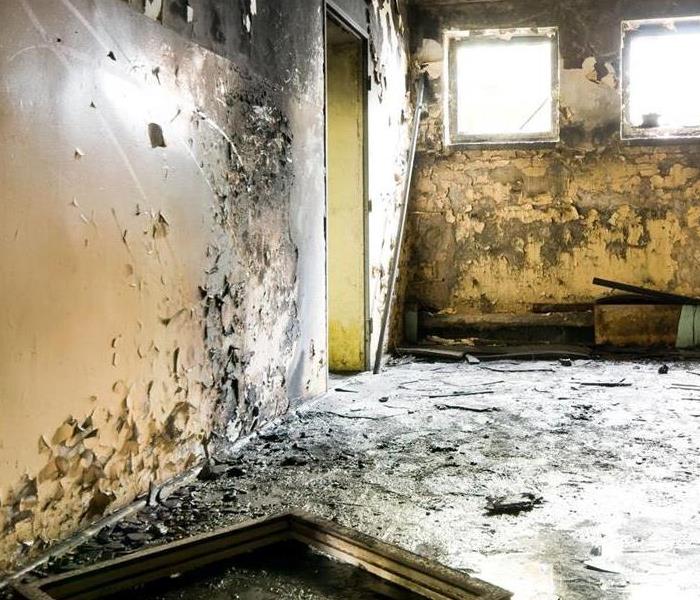 Mold Photo
Mold Photo
The Facts about Mold: For Everyone
What is mold?
The term “mold” is a colloquial term for a group of filamentous fungi that are common on food or wet materials. This includes the green Penicillium species that produces penicillin, and fungi that spoil our bread, fruit, cheese and crops. Most of these are Ascomycetes that produce a lot of spores.
The majority of the molds that grow on damp building materials are found in the soil and are adapted to grow on a wide variety of materials. Outdoors, molds live in the soil, on plants, and on dead or decaying matter. There are thousands of species of mold and they can be any color. Different mold species are adapted to different moisture conditions ranging from very wet to just damp. Many times, mold can be detected by a musty odor. Live spores act like seeds, forming new mold growths (colonies) under the right conditions. All of us are exposed to a variety of fungal spores daily in the air we breathe, both outdoors and indoors.
How mold gets into a house or building
Mold and fungal spores occur naturally outdoors, where fungi are the earth’s most important recyclers. Indoors, mold needs moisture to grow; it becomes a problem only where there is water damage, elevated and prolonged humidity, or dampness. Common sources of excessive indoor moisture that can lead to mold problems include:
- flooding from surface waters (i.e., overflowing rivers) or from severe storms;
- roof leaks from damaged or missing roofing materials, ice dams or blocked gutters;
- storm-driven rain through window frames, exterior walls or door assemblies;
- leaking pipes, sewer back-ups or overflows;
- damp basements or crawl spaces due to a high water table or poorly managed rainwater drainage; and
- condensation on cold surfaces.
How to prevent mold growth
The key to preventing and stopping indoor mold growth is to control excessive moisture and condensation. Keeping susceptible areas in the home clean and dry is critical. In general, mold will not grow indoors without water, dampness or excessive moisture.
Three main factors contribute to condensation of water on building surfaces:- Relative Humidity: Condensation occurs when the air is saturated with water and it cannot hold any more moisture. For example, steam generated from bathroom showers or from cooking can fill up the air with moisture, which will then condense into drops of water on cooler surfaces, such as mirrors and windows. Where possible, localized sources of humidity, such as clothes dryers, should be directly vented to the outdoors. To lower indoor humidity during warm, humid weather, air conditioners and/or dehumidifiers should be used. In chronically damp areas such as basements or crawlspaces, it is often recommended that dehumidifiers be used to maintain humidity levels below 60 percent.
- Temperature: Warm air holds more moisture than cold air. Condensation occurs when warm humid air comes into contact with a cold surface and the moisture condenses into water. This can often be seen on single-pane windows, where water condenses and then runs down, causing the wood frames and sills to rot and the wall under the windows to blister. Condensation can occur on exterior walls, particularly north-facing walls, if they are not properly insulated. Other chronically cold surfaces, such as cold water pipes, should be covered with insulation to help prevent condensation.
- Poor Ventilation: Indoor humidity can build up if there is not enough ventilation and exchange of indoor and outdoor air. Where there is little or no air movement, such as behind dressers and cabinets, surfaces can remain cooler than surrounding areas, which can lead to increased condensation and mold growth. It is recommended that the area be ventilated and the occupants use exhaust fans (vented to the outdoors) to remove moisture from high-humidity areas, particularly in bathrooms, kitchens and laundry areas. Furniture should be moved slightly away from walls so that air can freely pass behind it. Air should be allowed to circulate between rooms and regularly ventilate to remove humid air. Fans should be used as needed.
Other things that can be done are to clean and repair gutters regularly, make sure the ground slopes down and away from the home’s foundation and keep air conditioner drip pans and drain lines clean. In addition, in air conditioned buildings in hot and humid climates, vinyl wall coverings on the interior sides of exterior walls should not be used, as these materials can trap moisture, resulting in mold growth underneath them.
In the case of floods or leaking pipes, any standing water should be promptly removed and water-damaged materials should either be dried out and cleaned, or removed and replaced. Porous materials that are wet for more than 48 hours are likely to produce mold growth and should be discarded. In instances where the water damage is extensive, it is recommended that professional help, such as a commercial restoration company, be consulted.
If you think you may have mold or have had a water damage,please call SERVPRO of Virginia Beach at 757-431-1400.
Mold Prevention Tips
4/22/2016 (Permalink)
Mold. The very sound of the word is enough to make a person cringe.
Yes, mold can be good-- it's essential in making brie and penicillin, for example, but it can also be very, very bad, especially when it grows undetected in your home.Some Facts About Mold
Mold spores spread easily and cannot be completely eradicated. Mold can grow anywhere: on carpet, clothing, food, paper and even in places you can't see, such as the back of drywall, areas inside walls around leaking or condensing pipes, or above ceiling tiles. Not only is a mold problem difficult and costly to fix, but mold can also produce allergens and irritants (and rarely, toxins) that may compromise your health. So what can you do if you're concerned about mold growing on a property? The best approach is preventing mold before it becomes a problem. And the key to mold prevention is simple: moisture control. Mold Prevention Tips
Click below for nine ways to curb moisture indoors, and the mold that thrives on it. 9 Ways to Curb Indoor Moisture and Prevent Mold:
1. Identify problem areas and correct them. You can't mold-proof a property, but you can make it mold-resistant. Do an audit of the property: where are the problem areas? Does the basement flood? Do you notice frequent condensation on an upstairs window? Is there a water stain on the ceiling from a persistent leak? Preventing mold from growing or spreading might be as simple as ripping up carpet in a damp basement, installing mold-resistant products, or repairing damaged gutters. Or it may be a matter of major excavation and waterproofing. Whatever the case, address the problem now. It might cost some money up front, but it will surely be more costly down the road if mold continues to grow unchecked.
2. Dry wet areas immediately. Mold can't grow without moisture, so tackle wet areas right away. Seepage into the basement after a heavy rainfall, accumulation from a leaky pipe, even a spill on the carpet should be dried within 24 to 48 hours. If you've experienced a flood, remove water-damaged carpets, bedding, and furniture if they can't be completely dried. Even everyday occurrences need attention: don't leave wet items lying around the house, and make sure to dry the floor and walls after a shower. Don't leave wet clothes in the washing machine, where mold can spread quickly. Hang them to dry — preferably outside or in areas with good air circulation.
3. Prevent moisture with proper ventilation. It may be that your routine domestic activities are encouraging the growth of mold in the property. Make sure an activity as simple as cooking dinner, taking a shower, or doing a load of laundry doesn't invite mold by providing proper ventilation in your bathroom, kitchen, laundry room, and any other high-moisture area. Vent appliances that produce moisture — clothes dryers, stoves — to the outside (not the attic). Use AC units and dehumidifiers (especially in humid climates), but make sure they don’t produce moisture themselves by checking them periodically and cleaning them as directed by the manufacturer. Your energy-efficient property may be holding moisture inside, so open a window when cooking or washing dishes or showering, or run an exhaust fan.
4. Equip the property with mold-resistant products. Building a new home or renovating an old one? Use mold-resistant products like mold-resistant drywall or mold-resistant Sheetrock, and mold inhibitors for paints. Traditional drywall is composed of a gypsum plaster core pressed between plies of paper. Mold-resistant drywall is paperless — the gypsum core is covered in fiberglass, making the surface highly water-resistant. Moisture-resistant drywall is especially valuable in areas prone to wetness, such as bathrooms, laundry rooms, basements, and kitchens. Not only is traditional drywall more susceptible to mold than the paperless kind, but it is also difficult to rid of mold, and removal and replacement can be expensive. Mold-resistant gypsum board is also available; the core of the drywall is developed in such a way to prevent moisture absorption, and thus prevent mold growth.
5. Monitor humidity indoors. The EPA recommends keeping indoor humidity between 30 and 60 percent. You can measure humidity with a moisture. You'll also be able to detect high humidity by simply paying attention to potential problem areas of the property. Telltale signs of excessive humidity include condensation on windows, pipes, and walls. If you notice condensation, dry the surface immediately and address the source of moisture. (For example, turn off a humidifier if water appears on the inside of nearby windows.)
6. Direct water away from the property. If the ground around the property isn't sufficiently sloped away from the foundation, water may collect there and seep into your crawlspace or basement.
7. Clean or repair roof gutters. A mold problem might be a simple matter of a roof that is leaking because of full or damaged gutters. Have your roof gutters cleaned regularly and inspected for damage. Repair them as necessary, and keep an eye out for water stains after storms that may indicate a leak.
8. Improve air flow in your home. According to the EPA, as temperatures drop, the air is able to hold less moisture. Without good air flow in a property, that excess moisture may appear on your walls, windows and floors. To increase circulation, open doors between rooms, move furniture away from walls, and open doors to closets that may be colder than the rooms they’re in. Let fresh air in to reduce moisture and keep mold at bay.
9. Keep mold off household plants. They're beautiful and help keep your indoor air clean — and mold loves them. The moist soil in indoor plants is a perfect breeding ground for mold, which may then spread to other areas of your house. Instead of getting rid of your plants, try adding a bit of Taheebo tea to the water you give to your houseplants. The oil of this tree, which withstands fungi even in rain forests, helps hinder mold growth in plant soil and can be found at natural food stores.
Finally, educate yourself on your region's climate — be it the cold and wet Northeast, the hot and wet South, the hot and dry Southwest, or the cold and dry West — and how it responds to moisture. There is no one-size-fits-all solution when it comes to mold prevention. Knowing what works for your climate and your home is an important first step.





 24/7 Emergency Service
24/7 Emergency Service

